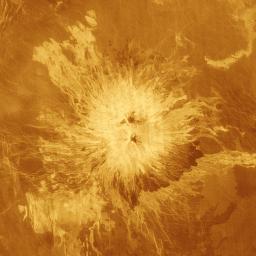
|
False Color Image of Volcano Sapas Mons
- Click the image above for a larger view
- Full-Res JPEG (3072 x 3072) (2.0 MB)
- Full-Res TIFF (3072 x 3072) (8.3 MB)
Caption:
This false-color image shows the volcano Sapas Mons, which is located in the broad equatorial rise called Atla Regio (8 degrees north latitude and 188 degrees east longitude). The area shown is approximately 650 kilometers (404 miles) on a side. Sapas Mons measures about 400 kilometers (248 miles) across and 1.5 kilometers (0.9 mile) high. Its flanks show numerous overlapping lava flows. The dark flows on the lower right are thought to be smoother than the brighter ones near the central part of the volcano. Many of the flows appear to have been erupted along the flanks of the volcano rather than from the summit. This type of flank eruption is common on large volcanoes on Earth, such as the Hawaiian volcanoes. The summit area has two flat-topped mesas, whose smooth tops give a relatively dark appearance in the radar image. Also seen near the summit are groups of pits, some as large as one kilometer (0.6 mile) across. These are thought to have formed when underground chambers of magma were drained through other subsurface tubes and lead to a collapse at the surface. A 20 kilometer-diameter (12-mile diameter) impact crater northeast of the volcano is partially buried by the lava flows. Little was known about Atla Regio prior to Magellan. The new data, acquired in February 1991, show the region to be composed of at least five large volcanoes such as Sapas Mons, which are commonly linked by complex systems of fractures or rift zones. If comparable to similar features on Earth, Atla Regio probably formed when large volumes of molten rock upwelled from areas within the interior of Venus known as'hot spots.'
Magellan is a NASA spacecraft mission to map the surface of Venus with imaging radar. The basic scientific instrument is a synthetic aperture radar, or SAR, which can look through the thick clouds perpetually shielding the surface of Venus. Magellan is in orbit around Venus which completes one turn around its axis in 243 Earth days. That period of time, one Venus day, is the length of a Magellan mapping cycle. The spacecraft completed its first mapping cycle and primary mission on May 15, 1991, and immediately began its second cycle. During the first cycle, Magellan mapped more than 80 percent of the planet's surface and the current and subsequent cycles of equal duration will provide complete mapping of Venus. Magellan was launched May 4, 1989, aboard the space shuttle Atlantis and went into orbit around Venus August 10, 1990.
Cataloging Keywords:
| Name | Value | Additional Values |
|---|---|---|
| Target | Venus | |
| System | ||
| Target Type | Planet | |
| Mission | Magellan | |
| Instrument Host | Magellan | |
| Host Type | Orbiter | |
| Instrument | Imaging Radar | |
| Detector | ||
| Extra Keywords | Color, Crater, Impact, Map, Mountain, Radar, Volcano | |
| Acquisition Date | ||
| Release Date | 1996-02-05 | |
| Date in Caption | 1989-05-04 | 1990-08-10, 1991-05-15 |
| Image Credit | NASA/JPL | |
| Source | photojournal.jpl.nasa.gov/catalog/PIA00203 | |
| Identifier | PIA00203 | |
